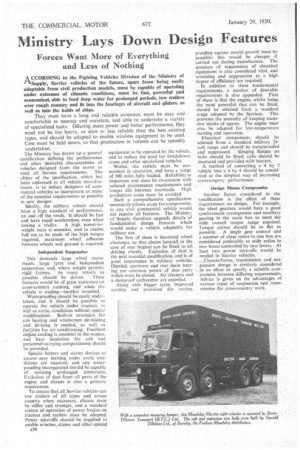Mi n i s t r yi Lays Down Design Features
Page 32

If you've noticed an error in this article please click here to report it so we can fix it.
• Forces Want More of Everything • and Less of Nothing
ACCORDING to the Fighting Vehicles Division of the Ministry of Supply, Service vehicles of the future, apart from being easily adaptable from civil production models, must be capable of operating under extremes of climatic conditions, must be fast, powerful and economical, able to ford deep water for prolonged periods, tow trailers over rough country and fit into the fuselages of aircraft and gliders, as well as into the holds of ships.
• They must have a long and reliable existence, must be easy and comfortable to operate and maintain, and able to Undertake a variety of specialized tasks. Offering more power and better performance, they must not be too heavy, or slow or less reliable than the best existing types, and should be adapted to enable wireless equipment to be used. Cost must be held down, so that production in volume can be speedily undertaken.
The Ministry has drawn up a general specification defining the performance and other desirable characteristics of vehicles designed from the outset to meet all Service requirements. The object of the specification, which has been addressed to all vehicle manufacturers, is to induce designers of commercial vehicles to incorporate as many of the essential requirements as possible in new "designs.
Ideally, the military vehicle should have a high standard of performance. on and off the roads. It should be fast and have rapid acceleration, even when
towing a trailer, A high power-toweight ratio is essential, and to enable full use to be niade of the high torque required, maximum wheel adhesion between wheels and ground is required.
Independent Suspension
This demands large wheel movements: large tyres and independent suspension, and, where weight permits, rigid frames. As many wheels as possible should be driven. —These features would be of great assistance on cross-conntry running, and when the vehicle is wading—another essential.
Waterproofing should be easily undertaken, and it should be possible to operate the vehicle .under tropical.. as Well as arctic, conditions without special modifications. Built-in provision for cab heating and windscreen de-misting
• and de-icing is needed, as well as facilities for air conditioning, Excellent engine cooling is essential in the tropics. and heat insulation for cab and personnel-carrying compartments should be provided.
Special battery and starter devices to ensure easy starting under arctic Conditions are required, and any waterproofing incorporated should be capable of resisting prolonged immersion. Exclusion of dust from all parts of the engine and chassis is also a primary requirement.
To ensure that all Service vehicles can tow trailers of all types and across country when necessary, chassis must be stiffer and stronger, and a standard system of operation of power brakes on tractors and trailers must be adopted. Power take-offs should be supplied to enable winches, cranes and other special A30 equipment to be operated by the vehicle. and to reduce the need for breakdown. crane and other specialized vehicles.
Withal, the vehicle must be economical in operation, and have a range of 300 miles fully loaded. Reliability is important and must be co-existent with reduced maintenance requirements and longer life between overhauls. High production costs must be avoided. Such a comprehensive specification necessarily alloWs scope for compromise, as any civil commercial vehicle would not require all features, The Ministry of Supply therefore appends details of fundamental design features which would make a vehicle adaptable for military use.
The first of these is increase wheel clearance, so that chains (overall in the case of rear bogies) can be fated to all driving wheels. Exclusion of dust is the next essential modification, and is of great importance in military vehicles. Dipstick apertures and rear Main bearing are common points of dust entry which must be closed. Air cleaners and a dustproof carburetter are essential.
Along with bigger tyres, improved cooling and provision for towing, proofing against mould growth must be possible; this would be cheaper if carried out during manufacture. The question of suppression of electrical equipment is also considered vital, and screening and suppression to a high degree of effieiency are required.
In addition to these fundamental requirements, a number of desirable requirements is also appended. First of these is that the engine, whilst being the most powerful that can be fitted. should be selected from a standard range adopted by the Services. This prevents the necessity ,of keeping excessive stacks of spares. The engine must also be adapted for low-temperature starting and operation.
Electrical components should be selected from a standard military 24volt range and shotild be waterproofed
and suppressed. Slinging flanges • on hubs should be fitted, cabs should be insulated and provided with heaters.
A method of converting a 4 by 2 • vehicle into a 6 by 4 should be considered as the simplest way of increasing cross-country performance.
Design Means Compromise
Another factor considered in the specification is the effect of these requirements on design. For example. the ideal gearbox would have a good synchromesh arrangement and auxiliary gearing in the main box to meet the wide overall torque range required. Torque curves should be as flat as possible. A single gear control and a number of close ratios in one box are considered preferable to wide ratios in,. two boxes.controlled by two .levers.,.At least two power take-offs would. be needed in heavier vehicles.
Chassis-frame, 'transmission and suspension design is similarly considered in an effort to specify a suitable .cornpromise between differing requirements. Advice is given on the advantages of various types of suspension and transmission for cross-country work.




















































































